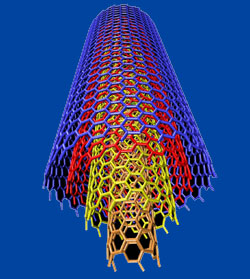Carbon nanotubes may be used as a raw material for bulletproof suits. The materials in them stop the bullet and prevent it from entering the body
Yoram Ored, "Galileo" magazine

Most of the materials used to build bulletproof protective suits are very high strength polymers, including Kevlar and Twaron. These materials stop the impacting projectile by dispersing the force it exerts over a large area. In this way, the pressure on the large area decreases and prevents the penetration of the bullet. Despite the reduction of pressure, it is still possible in this situation to injure or damage the body's organs.
Recently, Australian researchers Zhang and Kausala Mylvaganam discovered that the carbon nanotubes have the ability to bounce back projectiles that hit them. This feature makes them good candidates for building bulletproof protective suits.
Unlike other materials in use (such as Kevlar, as mentioned above), the nanotubes initially absorb the projectile's motion energy and convert it into elastic energy. The kinetic energy decreases, due to its conversion to elastic energy, but the elastic energy is rolled back into the projectile as kinetic energy, and the projectile moves back out of the suit.
Since the nanotubes are hollow and very small in diameter, they are also very light, which is another advantage. Zhang and Kausla developed a computer simulation designed to examine the relationship between the radius of the nanotubes and their ability to stop projectiles at different speeds. They found that the larger the radius of the tubes, the greater their ability to stop projectiles at higher speeds.

6 תגובות
The kinetic energy of the penetrator at the moment of impact is: the velocity of the penetrator at the moment of impact squared times the mass of the penetrator divided by two.
Armor has to deal with the kinetic energy of the intruder at the moment of impact (which is what is relevant to the case before us - and not the momentum). The kinetic energy of the penetrator at the moment of impact is: the velocity of the penetrator at the moment of impact squared times the mass divided by two.
In armor composed of resin-bonded fibers using a matrix method, the fracture process happens in two ways. One way, the speed of the penetrator (the kinetic) does not give the target enough time to deflect the penetrator, and the penetrator will penetrate the fibers by failure caused by compression and shear. The other way is that as the penetrator slows down It begins to bend the armor plate and the fibers begin to elongate and split. Composite armor is a soft armor material and its ability to stop the penetration of intruders is limited. The most effective armor is a combination of layers made of different materials. These layers will usually include an outer ceramic layer that will act to dull and wear out the intruder And strong flexible layers behind it that will spread the energy over a larger area and time and will also capture the intruder and the fragments of the ceramic.
The problem with projectiles is that they apply high pressure at the point of impact and this allows them to penetrate.
Pressure, as we know, is a force divided by area, so one of the ways to deal with it is to distribute the force over a larger area.
In fact, this is about two alternative ways to lower the pressure - one by lowering the force and the other by increasing the area.
The way of the collapse is based more on the lowering of the force since the stopping of the ball is spread over a longer period of time. It is based on the fact that the change in momentum is the product of force over time and as time increases, the same change in momentum is achieved using less force.
The way of collapse is more suitable, naturally, for situations where it is not necessary to absorb many hits in the same place. It is accepted, for example, in cars that are supposed to protect the passengers during a collision.
What is beautiful about the current solution is that it benefits from both worlds, on the one hand, and is able to block many attacks in the same place, on the other hand. On the one hand, it extends the duration of the collision thanks to the elasticity of the nanotubes, thereby lowering the applied force, and on the other hand, it spreads the force over a large area, as do other materials used today in protective vests.
Tam's question - isn't the fact that the tubes push back the bullet and don't "absorb it" actually a disadvantage? Wherever energy needs to be absorbed, materials are sought that are actually not elastic, but materials that will "collapse" and absorb all the energy.
Reminds me of Crysis, when will SUPERSPEED and SUPERSTRENGTH be made for us as well? Those who haven't played, let them play! (But first he buys himself a computer to run this shit)